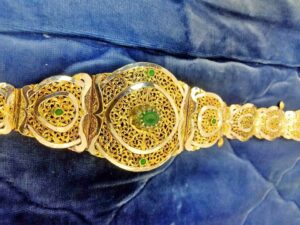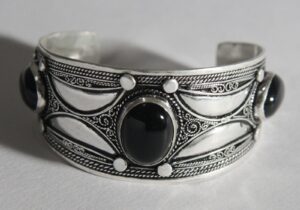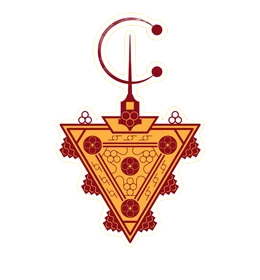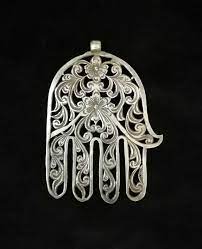Handmade Jewelry: A Timeless Art Form
What is the history of handmade jewelry?
Handmade jewelry has been around for thousands of years and is considered one of the oldest forms of human expression. Jewelry has been used to commemorate special events, celebrate milestones, and tell stories. From the ancient Egyptians to the indigenous peoples of the Americas, handmade jewelry has been a part of human culture and history.
What Kind of Jewelry is Morocco Known For?
Morocco is known for a variety of traditional and contemporary jewelry styles, including Berber jewelry, tribal jewelry, and more modern, minimalist pieces.
The History of Handmade Jewelry
Jewelry making can be traced back to the Neolithic era, where evidence of beaded necklaces, bracelets, and earrings have been found. Ancient civilizations, such as the Egyptians and Greeks, are known for their intricate gold jewelry and advanced metalworking techniques. During the Renaissance, jewelry making became an art form and was commissioned by wealthy families. In the 19th and 20th centuries, jewelry making was revolutionized with the introduction of new materials, such as glass beads and synthetic stones. Today, handmade jewelry continues to be popular and is a thriving industry.
Berber Jewelry: A Unique Expression of Culture and Heritage
What is Handmade Jewelry?
- Handmade jewelry is a form of jewelry that is crafted by hand, using traditional techniques and materials.
- Each piece of handmade jewelry is unique and reflects the skill and creativity of the artisan who made it.
What is Berber Jewelry?
Berber jewelry is a form of handmade jewelry that is specific to the Berber people of North Africa. The Berbers are an indigenous group with a rich cultural heritage and a long history of jewelry making.
Berber jewelry is known for its intricate designs and use of natural materials such as silver, bronze, and gold. Each piece is unique and tells a story, with symbols and motifs that have cultural significance and are steeped in tradition.
What are Berber Symbols in Jewelry?
Berber symbols in jewelry often represent aspects of Berber culture and history, such as fertility, protection, and good luck.
For example, Berber women wear heavy silver bracelets to protect themselves from evil spirits, and Berber men often wear silver pendants that represent their social status and wealth.
These symbols may take the form of specific patterns, such as zigzags and spirals, or more abstract representations, such as animals and other natural forms.
In addition to its cultural significance, Berber jewelry is also renowned for its beauty and craftsmanship. Berber artisans use traditional techniques, such as hand-hammering and engraving, to create intricate designs and patterns. This not only results in beautiful jewelry, but it also helps to preserve the cultural heritage of the Berber people.
The Most Known Pieces of Berber Jewelry
Berber necklaces:
Berber necklaces, such as the traditional Amazigh necklace, are a staple of Berber jewelry and are made with a variety of materials, including beads, silver, and gold. Berber necklaces often feature pendants with symbolic meaning, such as the eye, which is believed to protect the wearer from evil.
Berber bracelets:
Such as the traditional berber bracelet, are worn on the wrist and are often made with colorful beads and metal elements. Berber bracelets are believed to bring good luck and are sometimes given as gifts to loved ones.
Berber earrings:
Berber earrings are an important part of Berber jewelry and are typically made with silver, gold, or other precious metals. Berber earrings often feature intricate designs and symbolic elements, such as the eye or the Berber star.
Berber amulets:
Berber amulets are small, decorative objects that are believed to bring good luck and protection to the wearer. Berber amulets are made with a variety of materials, including silver, gold, and semi-precious stones, and are often worn on necklaces or bracelets.
Handmade Jewelry and Engagement Rings
Handmade engagement rings are a popular choice for those looking for a unique and personal expression of love. Vintage emerald cut diamond engagement rings and vintage engagement rings with sapphire accents are sought-after styles, while loose antique diamonds are a popular option for those looking to add a touch of history to their ring. Handmade chain necklaces and handcrafted engagement rings are also popular options for those looking for a personal and handmade touch.
Do antique rings hold their value?
Antique rings can hold their value if they are well-preserved and in demand. The value of antique jewelry is determined by several factors such as rarity, historical significance, craftsmanship, and demand. However, the market for antique jewelry can be volatile and subject to fluctuations, so it is important to do research and get a professional appraisal before making a purchase.
Moroccan Jewelry and Necklaces
Moroccan jewelry, including Moroccan necklaces, is known for its intricate designs and bright colors. Berber jewelry, including traditional berber necklaces and bracelets, is a unique expression of the culture and heritage of the Berber people of Morocco. Whether you are looking for a beautiful piece of jewelry to wear or a piece of history to admire, Berber jewelry is a must-see for anyone interested in handmade jewelry.
Key Pieces of Berber Jewelry
1- Tazerzit
is a typical fibula or necklace that is both functional and symbolic in Amazigh cultural heritage. Its use was popular among North African tribes as a common item of Berber cultural jewelry.
It is made up of a triangle under a ring or semicircle, as well as a pin to keep unsewn clothing together.
2- Mdama
Mdama is a traditional belt that is frequently used to tight caftans and takchitas. This item is produced  from a variety of materials and comes in a wide range of styles and designs. Most notably, the original mdama was once part of a woman’s wedding.
from a variety of materials and comes in a wide range of styles and designs. Most notably, the original mdama was once part of a woman’s wedding.
3-Khamsa
This is a Moroccan classic jewelry that can be found in almost any item, such as a necklace, a bracelet, a pendant, an anklet or a set of earrings
Khamsa is a Moroccan-Jewish symbol representing a hand with the capacity to ward off evil and protect the owner from bad karma.
This classic Moroccan jewelry can be found in almost any item, such as a necklace, a pendant, a bracelet, a set of earrings, or an anklet.
4- Moroccan silver bracelets
Moroccan silver bracelets are another key component of any traditional jewelry collection.
These products are often worn either alone or in layers to provide thickness to the wrist.
Although the most popular are made of 925 silver, there are several bracelet sets crafted from gold ( usually worn at weddings or special occasions).
There are numerous reproductions of real silver bracelet sets available currently, and while they are considerably cheaper than the originals, they nevertheless manage to capture the beauty and character of Moroccan jewelry history.
5- Khalkhal
It might be tiny or heavy, like the Fassi Khalkhal, which is kind of like a cuff, etched with different flower forms, and has a silver chain that turns it into a double layer anklet.
Berber jewelry is more than just a fashion accessory, it is a symbol of cultural identity and a testament to the skill and artistry of the Berber people. Whether you are looking to add a touch of cultural heritage to your personal style or simply appreciate the beauty of handmade jewelry, Berber jewelry is a must-have for any jewelry collection.
how hard to find Antique Moroccan Jewelry ?
Antique Moroccan jewelry is far more valuable than updated items. Not only that, but obtaining an authentic piece of jewelry from a long time ago is a difficulty in and of itself, even more difficult than expensive Moroccan rugs handcrafted using traditional techniques and high-quality materials.
Finding antique Moroccan jewelry will be a difficult challenge, whether you buy in the Souks of historic Medinas or browse online.
Most Moroccan women inherited such accessories from their moms and grandmothers, making it nearly impossible to split with them due mainly to the special value they represent.
While it is difficult to find a vintage jewelry shop in Morocco, original items may still be found in historical cities such as Marrakech, Fez, Tangier, and Chefchaouen.
Conclusion
Handmade jewelry is a timeless art form that has been a part of human culture for thousands of years. Berber jewelry is a unique expression of the culture and heritage of the Berber people of North Africa. With intricate designs, bright colors, and symbolic meaning, Berber jewelry is a beautiful representation of the creativity and craftsmanship of the Berber people. Whether you are looking for a beautiful piece of jewelry to wear or a piece of history to admire, Berber jewelry is a must-see for anyone interested in handmade jewelry.

